Archived Article Detail
By Thomas P. Moore
Need to search for a keyword, title or article on this page? On your keyboard, hold down the “Ctrl” and “F” key and a “Find in page” box will appear at the bottom of your screen. Type in your keyword and check the “Highlight All” box and like magic your keyword will appear highlighted as you scroll up and down the page!
WHAT’S NEW IN THE MINERAL WORLD ARCHIVE – posted on 9/11/2010
Here in the Sonoran Desert we’ve had an unusually hot, long summer, and now, as triple-digit temperatures finally recede, we await our autumn of sorts, pretending that somehow it could be one of those astringent ones “when yellow leaves, or none, or few do hang / Upon those boughs which shake against the cold…” –what would Shakespeare have thought of Tucson in August?! Of course, the very best news for mineral people is that the Denver Show will be happening soon. To help you get stoked for it (whether or not you’ll be going to it), here are a few new mineral items at venues that you can visit without having to check in (for at least $15, these days) a single piece of hold baggage.
New on the Web
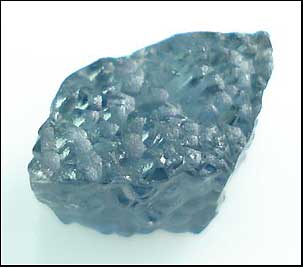
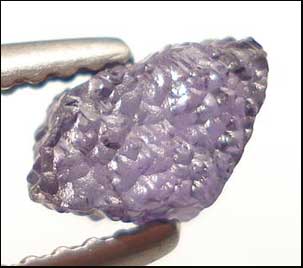
Top: in fluorescent light. Bottom: in incandescent light.
Civil Minerals specimen and photos.
Josh Baimel of Civil Minerals (www.CivilMinerals.com) has recently posted an update to his site which describes, believe it or not, “color-changing blue garnet crystals” from an alluvial gem-digging site at Bekily, Madagascar. I quote from Josh: “The blue garnet rough is exceedingly rare, and it is typically found in rough nodules and shards, with some gemmy pieces fetching over $2,000/carat for those stones that show the best blue color and potential for cutting larger stones. And the odds of finding a crystallized blue garnet among the shards of gem rough harvested from this locale are about 1,000 to one…nearly all the pieces that are crystallized end up being cut anyway into gemstones. These crystals actually change color depending upon the light source…The blue color is very strong in fluorescent light, as well as in direct sunlight. The color turns to purple under incandescent lighting…Research that has been performed on the blue garnet gem rough from this locale shows that this variety of garnet is actually a hybrid of sorts, possessing characteristics of both spessartine and pyrope.” One interprets this last to mean that the composition is somewhere along the scale between spessartine (with Mn2+ in the first cation site) and pyrope (with Mg2+ in that site). The partial crystal shown here has intricate surficial scallops on what are probably dodecahedron faces, and the other half-dozen or so crystals on the site look much the same. The crystal has been photographed in fluorescent light (pale blue) and in incandescent light (pale purple). Certainly, as Josh says, these are intriguing specimens, and naturally they’re not cheap: Josh asks $1,095 for the pictured 7.5-mm crystal. Bekily lies in the Androy region of Toliara Province in south-central Madagascar, and since the 1990s the site has been known to gemologists for producing faceting-grade garnets with an “alexandrite-type” color change—although I think that this is the first time I’ve seen anything approaching collector-quality crystals of the unusual garnets being sold on the web.
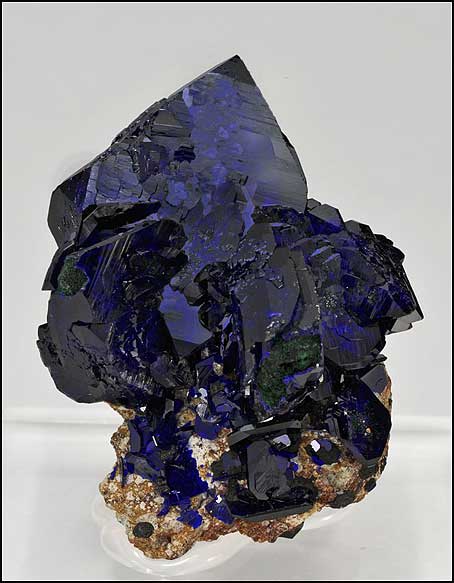
Fabre Minerals specimen and photo.
In my recent print report from July’s San Francisco Show (September-October 2010 issue), I noted that Evan Jones has come into a hoard of superb new azurite specimens from the Milpillas mine, Sonora, Mexico, with unusually brilliant blue azurite crystals in groups to cabinet size. The find was made in May of this year, and by now the specimens have to some extent gotten around—and so you may see a selection of about 20 fine pieces on Jordi Fabre’s site (www.fabreminerals.com). The tabular azurite crystals are of the familiar Milpillas type, i.e. their vivid color and high luster flash at the viewer from thin surface coatings of azurite over sharp malachite pseudomorphs after an earlier generation of azurite crystals. Other specimens from the same find now being offered by Jordi show razor-sharp malachite pseudocrystals, some with botryoidal blue plancheite, others with microcrystals of chrysocolla over quartz druses. Now properly regarded as one of the world’s greatest azurite localities, past or present, the Milpillas mine is still going strong and bears frequent checking in on—but anchor yourself in the article in our “Mexico V” issue (November-December 2008). The projected lifetime of the mine is only a few more years, so the current bounty will cease permanently by then, if not sooner.
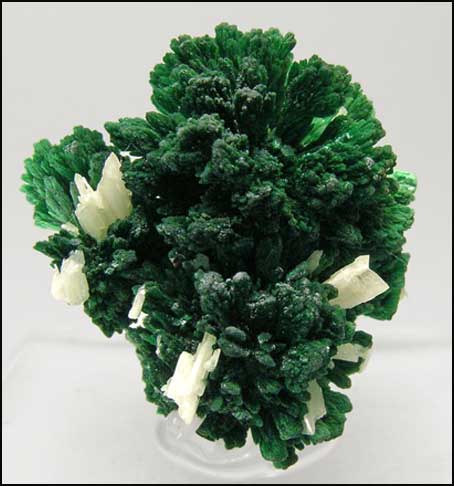
Fabre Minerals specimen and photo.
Jordi Fabre has also recently posted seven dramatic specimens—from 2.4 to 11.4 cm—of malachite from the famous Bou Beker mines, Touissit district, Oujda, Morocco. These beauties are loose sprays and groups of interconnected sprays of brilliant green malachite crystals with, as an extra feature, pearly white cerussite crystals perching here and there on them. This is also a find from May of this year; Jordi picked up his specimens at the 2010 Ste.-Marie-aux-Mines Show, where they made their debut on the market.
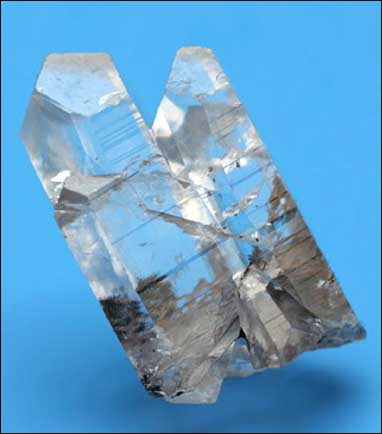
China. Andy Seibel specimen and photo.
The mines of the Dachang polymetallic deposit, south of Nandan and west of Hechi in China’s Guangxi Zhuang Autonomous Region, began around the turn of the millennium to produce sparse numbers of gorgeous “quartz-like” calcite crystal specimens. Usually these consist of loners or parallel groups of transparent, colorless calcite prisms with medium-angle rhombohedral terminations, looking startlingly like quartz at first glance—until you notice their silky luster and internal cleavage planes. The pellucid quartz-like calcites of Dachang have never been in abundant supply, and lately they have seemed to practically disappear from the market; however, Andy Seibel (www.andyseibel.com) has posted a page where you may shop for single crystals and parallel groups of Dachang calcites with individual crystals reaching 7 cm long.

Geologic Desires specimen and photo.
Then there are the pretty new calcite specimens from the Roncari trap rock quarry near East Granby, Hartford County, Connecticut. This old locality is best known for its superb datolite and babingtonite specimens, but in the mid-2000s there was a find of specimens showing sharp, milky white to transparent and colorless, scalenohedral calcite crystals to 10 cm in fetching groups, and also matrix specimens with the calcite crystals accompanied by colorless prisms of quartz. The latest update on Mike Walter’s Geologic Desires site (www.geologicdesires.com) offers a few new Roncari quarry specimens showing calcite in the aforementioned white to colorless scalenohedrons; blocky calcite crystals to 3 cm which are tinted red-brown by hematite overgrowths and inclusions; fat, gleaming quartz crystals to 4 cm; and some attractive, pale green plates of prehnite too. Shown here is one of Mike’s more attractive thumbnail-size Roncari calcites: a fine potential addition to anyone’s Contemporary New England suite.
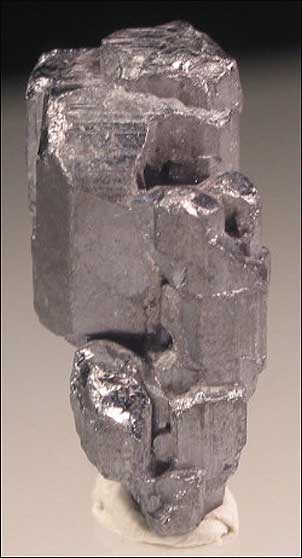
Bolivia. Khyber Minerals specimen and photo.
One of the richest sites on the web—which accordingly has been mentioned several times in this space—is Khyber Minerals (www.khyberminerals.com), where good worldwide specimens of many kinds, including, often, some surprising kinds, are offered for sale. A June 29 posting of specimens from Bolivia has some extremely interesting items to show: for one, there are six fine thumbnail-size stephanite specimens from the Porco mine, Agua de Castilla, Quijarro Province, Potosí Department. As I discovered in talking to Alfredo Petrov at the 2010 Tucson Show, the Porco mine, although one of the very first silver mines inaugurated by Spanish conquerers in the 16th century, is still producing ore, although it was not until this past year’s “new finds” that it has released significant mineral specimens to the market. I mentioned these facts, and the new stephanites I saw with Alfredo, in my 2010 Tucson report (in the May-June 2010 issue), but we could not run a picture with the report. The photo here, though, from the Khyber Minerals site, should make clear how snazzy and sharp these stephanite thumbnails from Porco can be. The specimens on hand range in size from 1.3 to 2.5 cm, and in price from $100 to $200—excellent bargains, if you ask me.
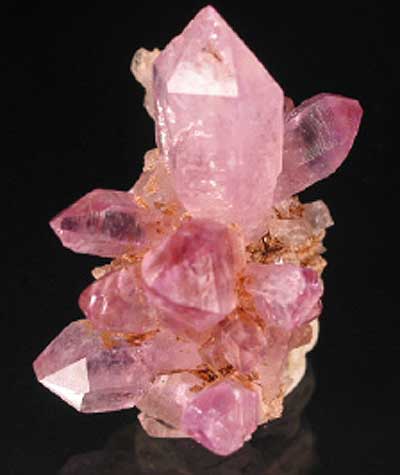
Khyber Minerals specimen and photo.
Also on the Khyber Bolivia page you will find some miniatures of the very rare cronstedtite which the dealership acquired in 2008 from a miner at the locality, namely the famous Siglo XX mine, Llallagua, Potosí (see the article in March-April 2006). Cronstedtite appears on these specimens as gleaming, slightly rough-surfaced hemispherical aggregates of microcrystals on limonite matrix, the dark greenish black to jet-black hemispheres reaching 1 cm across. On the same page are four very pretty clusters of pale violet, fat, sceptered amethyst crystals, the clusters from 4.4 to 6.3 cm, with pointed scepters sticking out in all directions from the matrix. No, the locality isn’t the well known Anahi mine in easternmost Bolivia but rather a place called Aki Salla, Potosí district, Potosí Department. This is an occurrence (of unspecified geological type) I had never heard of before; if I’d had to guess I’d have said that these amethyst specimens came from the intermittently generous quarries in basalt flows near Osilo, Sardinia, Italy.

Khyber Minerals specimen and photo.
Another major news item from the 2010 Tucson Show was world-class coquimbite specimens found in 2009 at the Javier mine, Ayacucho Department, Peru: sharp, transparent purple, hexagonal short-prismatic crystals to 5 cm in groups with other sulfate species, brought in by Jaroslav Hyrsl and at once distributed widely about the market. An August 11 update on the Khyber Minerals site offers several miniature to small-cabinet-size specimens of the new coquimbite, with good, pale purple crystals to 1 cm in jumbled groups. Unfortunately the specimens are misattributed both to the “Ortega prospect” (recently a source of green augelite specimens) and to the Huanzala mine (of pyrite and pink fluorite fame)—you may trust Jaroslav that they are in fact from the Javier mine. They are superb representatives of their species, and this is the best lot I’ve seen anywhere since this year’s Tucson Experience.
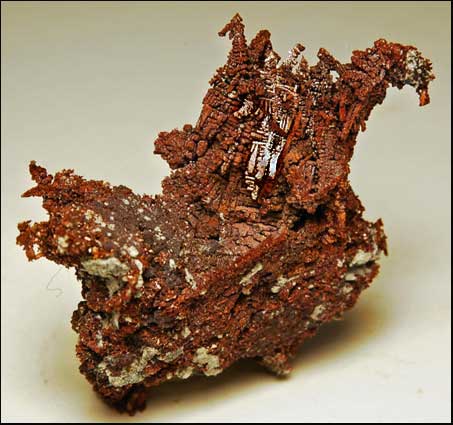
Lehigh Minerals specimen and photo.
Time now for a series of news flashes concerning native copper. Lehigh Minerals (www.lehighminerals.com) has a July 24 update showing about 20 miniature to small-cabinet-size specimens of copper from a discovery last year on the 6590 level of the Bingham Canyon mine, Salt Lake County, Utah. Although an important source of copper and molybdenum ore, this huge open-pit mine has never particularly excelled in crystallized mineral specimens—but the copper specimens taken out in 2009 rank as the best for this species found in the past 30 years or so of mining at Bingham Canyon. There were just two flats in all, and most of the best pieces are now with Lehigh Minerals although some, of course, are already sold. Complex dendritic growths of bright copper crystals form lustrous “ladders” to 8 cm, either alone or on matrix of white quartzite. For a thorough account of the Bingham Canyon mine, by the way, see Jerry North’s recently published book Displays of Nature, reviewed in July-August 2010.
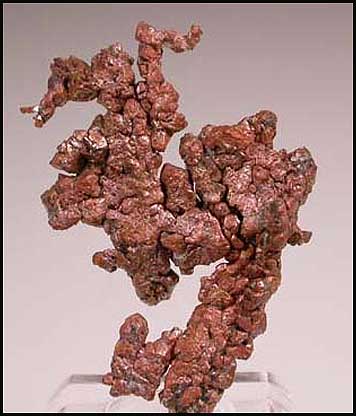
David K. Joyce specimen and photo.
When thinking of copper we’re not likely to flash to Nova Scotia, but in fact the Colonial mine on Cape d’Or, at the mouth of the Bay of Fundy, was worked for the native metal between 1897 and 1905, and modern collectors not too busy searching for zeolites in the basalt cliffs around the Bay sometimes can find decent copper specimens in outcrops near the mine site. The sheets of copper crystals are found in seams between blocks of altered basalt, with small crystals of stilbite, heulandite, apophyllite, etc. Canadian-minerals specialist David K. Joyce recently acquired 20 specimens of Cape d’Or copper from a Nova Scotian collector, and you may see them now on his site (www.davidkjoyceminerals.com). The specimens are loose, branching groups (from 3.5 to 7 cm) and flattened sheets of subhedral, fairly lustrous copper crystals. Not “world-class” copper, admittedly, but an interesting locality item nevertheless: did you know that Cape d’Or (“Cape of Gold”) was named such by early French settlers because the copper exposed in the cliffs of the headland glinted like gold (as it seemed to them) in the sunlight?
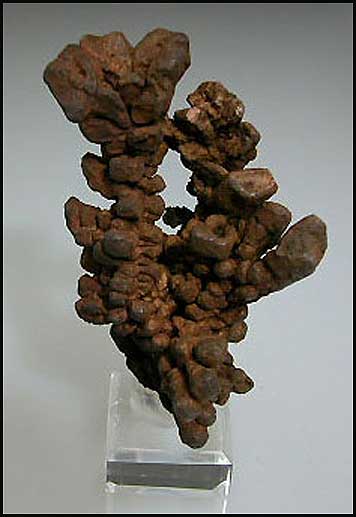
Michigan. North Star Minerals specimen and photo.
The copper display concludes with some major specimens from the “Copper Country” of northern Michigan. Ross Lillie of North Star Minerals (www.northstarminerals.com) has an August 26 posting that shows off many majestic old-timers, some from his own collection, some from the recently acquired Paul LaBonte collection, with sharp copper crystals in excess of 1 cm in heavy clusters and treelike aggregates to 12 cm. The specimens hail from various mines including the Ojibway, Pheonix, Old Copper Falls, Empire, Indiana, and Centennial mines; most of the specimens date to the 19th-century heydays of such famous diggings. Ross also offers a wonderful silver miniature from the classic Wolverine mine; antique calcite-enclosing-copper specimens; excellent colorless and transparent calcite clusters; epidote crystals, analcime crystals, and more polished datolite nodules than I cared to count. This is truly a fine stash of specimens from one of the most venerated of classic U.S. localities.
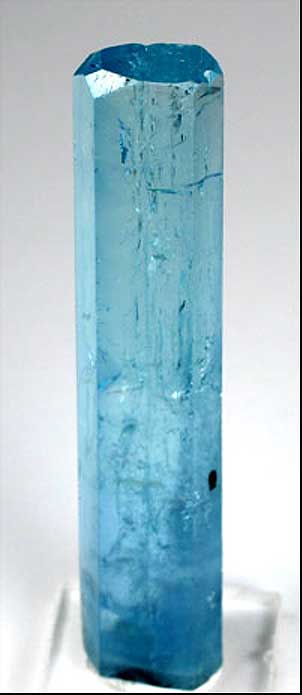
Colorado Gem and Mineral Company specimen and photo.
On rare occasions in the late 1990s, fine gem-quality crystals of aquamarine reached the international market from an unspecified locality in Thanh Hoa Province, Vietnam. I have not seen any of these for some years, but now Jack Lowell’s Colorado Gem and Mineral Company (www.coloradogem.com) is showing off a few gorgeous crystals from a “new find” at the place. The rich medium-blue, sharp, lustrous, totally gemmy aquamarine crystals range from 4.5 to 7 cm, and most of those shown on the site are doubly terminated at that. The crystal shown here, 6 cm long, is priced at $2750.
On the web you can link to this, link to that, then link to another thing, and you will often be glad to have done all that, for you’ll find yourself staring at something you’d never have guessed could be there (“there”…where is cyberspace anyway? is it somewhere near Delaware?). This time I found myself, at one point, inspecting a site called The John O’Dwyer Collection (www.odwyerminerals.com), ogling a diversity of specimens from the great Broken Hill mine, New South Wales, Australia, and from the collection of Mr. O’Dwyer, a former Broken Hill miner who is selling off the collection piece by intriguing piece. Of course, many items are already gone and no longer visible on the site, but there still remain examples, in a wide range of sizes and (frankly) of qualities, including Broken Hill standbys like rhodonite, hedenbergite, pyromorphite, and spessartine, and exotic specialties such as bannisterite, pyrosmalite and alabandite. Try finding anything like these on the main highway of mineral commerce these days.
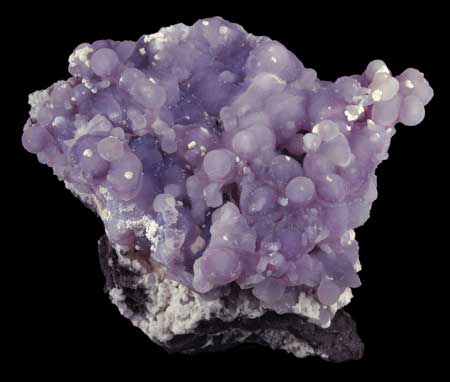
The Arkenstone specimen and photo.
Rob Lavinsky of The Arkenstone (www.irocks.com) has just moved his thriving business to a new, much larger Mineral Gallery in Dallas (see below), and so it’s understandable that his site has been rather quiet of late. But I do recommend a look at his ten or so specimens, mostly miniatures, of the new purple quartz “balls” recently found in the N’Chwaning III mine, Kuruman manganese mining district, South Africa. I recall seeing some early-arriving specimens of this material at the 2009 Denver Show, and it’s good to see a few more, as they’re very attractive and certainly “different” for quartz specimens. Translucent lavender spheres with sparkling surfaces form loose, grapelike clusters, or spread themselves out on matrix of chalky white calcite shot through by black manganese oxides.
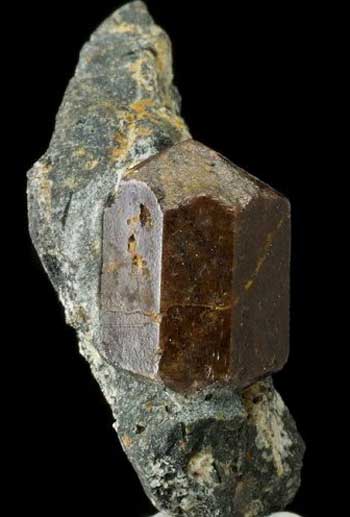
Trinity Minerals specimen and photo.
Another familiar presence in these reports is John Veevaert’s Trinity Mineral Company (www.trinityminerals.com), which weighs in now with miscellaneous acquisitions from the Springfield Show, as well as with something elusive from Russia: 14 miniature to cabinet-size specimens showing very sharp crystals of lorenzenite in matrix, from the world’s only good locality for macro-specimens of the rare Na-Ti silicate: Flora Mountain, Lovozero Massif, Kola Peninsula. Specimens showing textbook-sharp monoclinic lorenzenite crystals to several centimeters half-embedded in an odd-looking gray rock first began appearing at about the time of the Soviet Union’s collapse, and John’s new lot contains specimens which, I believe, are about as good as all but the very best from that period in the early 1990s. Very sharp, opaque chocolate-brown to yellow-brown lorenzenite crystals from 1 to 2 cm are half-embedded in that peculiar gray rock, which John calls schist but which probably is, rather, “lujavrite,” a kind of nepheline syenite characteristic of Lovozero and cited by Russian sources as the host for lorenzenite crystals on Flora Mountain (see, e.g., I.V. Pekov’s Lovozero Massif: History, Pegmatites, Minerals, 2000).
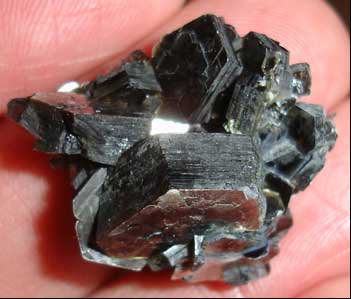
Chuck’s Rocks specimen and photo.
How about some news from another site which is new to these reports and is new, as a matter of fact, on the web altogether? The dealership called Chuck’s Rocks (www.chucksrocks.com) is run by Chuck Stilson, a geologist and mining engineer who works in Virginia but owns a claim called the “Sleeping Princess mine” in the Pikes Peak country of Colorado, where he digs every summer. Hence most of the minerals on his site are good but familiar-enough examples of smoky quartz, “amazonite” microcline, goethite, etc., from Colorado. What grabbed me instead was a selection of elegant thumbnails of muscovite from a locality I’d never heard of: “Jones Creek, Amelia, Virginia.” The hexagonal-tabular muscovite crystals are silvery gray to brownish and very sharp, forming little groups without matrix, and specimens are mostly priced under $10. No, these don’t show the amazing green gemminess of some otherwise similar-looking specimens from the Lattimore-Shelby area, Cleaveland County, North Carolina, but they are nevertheless very fine small muscovite specimens. Chuck has assured me of his intention to glean some information about the locality and its current collecting status.
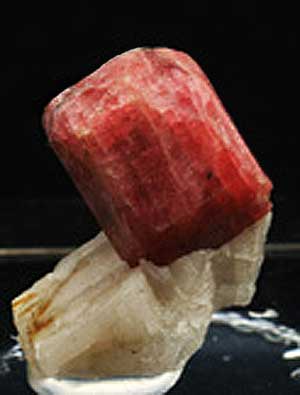
Williams Mineral Company specimen and photo.
Keith Williams of Williams Mineral Company (www.williamsminerals.com) appears each year at the Denver and Tucson “main” shows with mixes of one-of-a-kind specimens old and new. Among these, almost every time, are many thumbnails, and among these are many classic items from U.S. East Coast localities. Thus my friends know where I can often be found at the ends of the big shows: hanging mournfully around Keith’s booth, saying goodbye forever to this or that choice northeastern U.S. thumbnail which I can’t afford (you don’t get the best from Franklin, Phoenixville, Haddam Neck, or the Maine pegmatites for just a few nickels). Well, the Williams Mineral Company site now offers a highly addictive 12 pages of desirable thumbnails, including, indeed, more than you might expect from the Northeast: perhaps the Franklin rhodonite shown here (Keith is asking $150 for it) will inspire you to visit. I should mention also that Keith custom-builds mineral cabinets; just contact him to talk about specifications and prices.
A Mineral (Fossil?) Specimen from Madagascar

Antsiranana, Madagascar. Julien Raoul specimen and photo.
In August I got an e-mail from Julien Raoul, a Frenchman who lives in northern Madagascar and works a lot in the “demantoid diggings” at Antetezambato (see the articles in May-June 2010 for the scoop on this exciting new locality for gemmy crystals of green grossular). Julien wanted to tell me about what is said to be—and I can believe it—an absolutely unique specimen from Antetezambato, found in late April 2010 and sold to Julien during the first week of May. The specimen has been verified at the French Natural History Museum, Paris, as exactly what it looks like from its picture: a demantoid perimorph after fossilized coral. Demantoid (i.e. green grossular) is the only substance present, the coral having long since vanished, and this demantoid is quite gemmy. None of the workers at Antetezambato recalls ever having seen anything like this before, and the area of the diggings which yielded it is now largely abandoned. The perimorph is for sale: if interested, write to Julien at j_raoul@hotmail.fr.
California Mineral Auction on November 6
On Saturday, November 6, 2010, the firm of Ira & Larry Goldberg Coins & Collectibles (350 S. Beverly Drive, Suite 350, Beverly Hills, CA 90212) will be auctioning off a number of fine gem crystals and large, aesthetic “museum” specimens from four major dealerships: Bill Larson’s Palaminerals, Rob Lavinsky’s The Arkenstone, Wayne and Dona Leicht’s Kristalle and Kevin Ward’s Mineral Gallery. To quote from the flier, “These pieces range in size from finger-held gem specimens to extremely large and aesthetic plates”; pictured on the same flier are robust-looking, beautifully colored loose crystals of emerald, aquamarine and kunzite, and a big Sweet Home mine rhodochrosite/fluorite specimen. To participate live in the auction, come to the Goldberg offices in Beverly Hills, but bidding is possible also on www.goldbergcoins.com. An auction catalog may be viewed free ahead of time on the same website; alternatively, to order a catalog for $15, call 1-800-978-2646.
Arkenstone Opens New Headquarters
On August 29, Rob Lavinsky held the Grand Opening for his newly remodeled Arkenstone facility in Richardson, Texas, just outside Dallas. Wendell Wilson attended the festivities and reports that the new place is impressive indeed. The main showroom (designed by Kevin Brown—see the Texas Supplement) begins with an array of 31 cabinets, each with seven to 12 drawers and most of them topped by glass display cases. Next, turning a corner, one enters an area with 12 tall glass display cases on three walls containing over 460 shelf-feet of exhibit space; facing these is an imposing 28-foot line of seven security vaults where the most valuable specimens are usually stored. The nearly-10,000-square-foot complex also includes meeting rooms, other (smaller) display rooms with 15 more tall glass cases, and a room just for specimen photography, plus other workrooms, offices, preparation rooms and storage rooms. Any collector visiting the Dallas-Ft. Worth area should be sure to stop in and see Rob’s impressive layout.
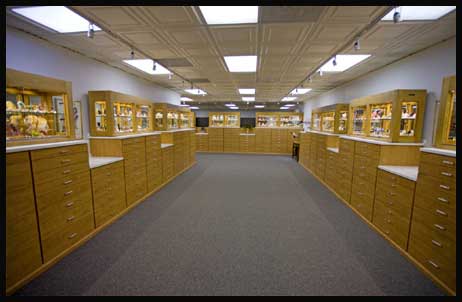
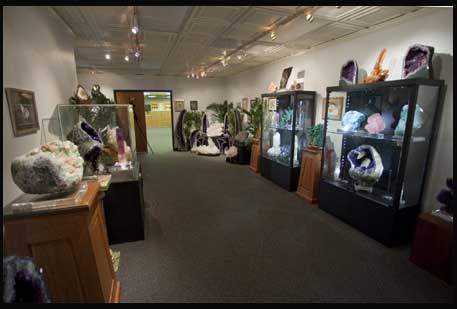
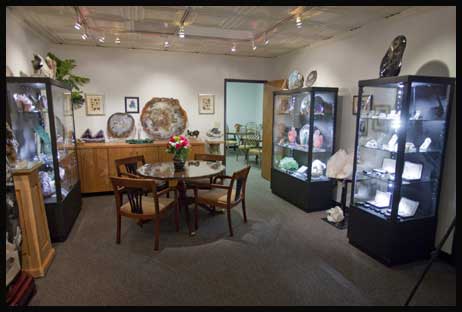
On to Denver!
For questions about this column, please email Tom Moore.
